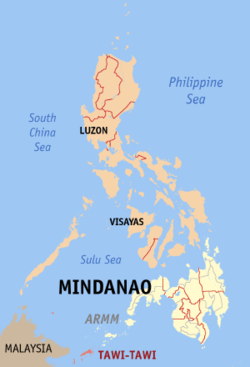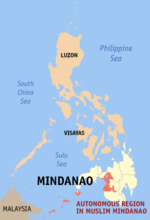Tawi-Tawi
| Tawi-Tawi | |||
|---|---|---|---|
| Province | |||
| |||
 Map of the Philippines with Tawi-Tawi highlighted | |||
| Coordinates: 05°12′N 120°05′E / 5.200°N 120.083°ECoordinates: 05°12′N 120°05′E / 5.200°N 120.083°E | |||
| Country |
| ||
| Region | Autonomous Region in Muslim Mindanao (ARMM) | ||
| Founded | September 11, 1973 | ||
| Capital |
Panglima Sugala ‡ de facto seat of government: Bongao ‡ | ||
| Government | |||
| • Type | Province of the Philippines | ||
| • Governor | Nurbert Sahali (Liberal Party) | ||
| • Vice Governor | Tati Ahaja (Liberal Party) | ||
| Area[1] | |||
| • Total | 1,087.40 km2 (419.85 sq mi) | ||
| Area rank | 74th out of 81 | ||
| Population (2010)[2] | |||
| • Total | 366,550 | ||
| • Rank | 62nd out of 81 | ||
| • Density | 340/km2 (870/sq mi) | ||
| • Density rank | 18th out of 81 | ||
| Divisions | |||
| • Independent cities | 0 | ||
| • Component cities | 0 | ||
| • Municipalities | 11 | ||
| • Barangays | 203 | ||
| • Districts | Lone district of Tawi-Tawi | ||
| Time zone | PHT (UTC+8) | ||
| ZIP code | 7500 to 7509 | ||
| Dialing code | 68 | ||
| ISO 3166 code | PH-TAW | ||
| Spoken languages | Вajau-Sinama, Тausug/Ѕulus, Zamboangueño Chavacano | ||
| ‡ Both Panglima Sugala and Bongao are recognized as capitals by the NSCB, but the provincial capitol is located in the latter. | |||
Tawi-Tawi (Chavacano: Provincia de Tawi-Tawi; Tagalog: Lalawigan ng Tawi-Tawi) is an island province of the Philippines located in the Autonomous Region in Muslim Mindanao (ARMM). The capitals of Tawi-Tawi are Bongao and Panglima Sugala. It is the southernmost province of the country, sharing sea borders with the Malaysian state of Sabah and the Indonesian North Kalimantan province, both on the island of Borneo to the west. To the northeast lies the province of Sulu. Tawi-Tawi also covers some islands in the Sulu Sea to the northwest, the Cagayan de Tawi-Tawi Island and the Turtle Islands, just 20 kilometres (12 mi) away from Sabah.
Etymology
The name of Tawi-Tawi is a projection of the Malay word "jauh" meaning "far." Prehistoric travelers from the Asian mainland would repeat the word as "jaui-jaui" to mean "far away" because of the distance of the islands from the mainland. The word "Tawi-Tawi" was picked up to later become the official name of the province.
History
Sibutu remained under Spanish rule until 1900.
Tawi-Tawi was previously part of the province of Sulu. On September 11, 1973, pursuant to Presidential Decree No. 302, the new province of Tawi-Tawi was officially created, separate from Sulu.[3] The seat of the provincial government was established in Bongao.
Geography
The province lies at the southwestern tip of the country, and consists of Tawitawi Island and 106 surrounding islands and islets with a combined land area of 1,087.4 km2 (419.8 sq mi).[1] Tawitawi Island itself has an area of 580.5 square kilometres (224.1 sq mi).[4]
The province has two seasons: dry and wet. The climate is generally moderate. The wettest months are from August to November. The other months of the year are generally dry with occasional rain showers.[5]
Biogeography
The main island of Tawitawi supports many endemic species and subspecies of vertebrates, invertebrates and plants unique to this island, plus some that are only shared with Sulu Province. These include the Tawitawi brown dove, the Sulu hornbill and the Sulu bleeding-heart, although this latter species may already be extinct. The rapid expansion of human settlements into forested areas together with clearance for agriculture in the last few decades has dramatically reduced the available habitat for most of the endemic species, many of which are now considered 'Critically Endangered' by the International Union for the Conservation of Nature.
Subdivisions
Tawi-Tawi is subdivided into 11 municipalities:
 Political map of Tawi-Tawi |
|
Most of the municipalities are located on the islands in the Sulu Archipelago. Two of them, Mapun, and Turtle Islands lie in the Sulu Sea. The municipalities are further subdivided into 203 barangays.
Demographics
| Population census of Tawi-Tawi | ||
|---|---|---|
| Year | Pop. | ±% p.a. |
| 1980 | 194,651 | — |
| 1990 | 228,204 | +1.60% |
| 1995 | 250,718 | +1.78% |
| 2000 | 322,317 | +5.53% |
| 2007 | 450,346 | +4.72% |
| 2010 | 366,550 | −7.22% |
| Source: National Statistics Office[2] | ||
Most of the people in Tawi-Tawi belong to the Sama cultural group.[5] Within this group are subgroups and named based on the location of the speaker. Sama Sibutu are those from the Sibutu-Sitangkai Island Group, Sama Simunul are those from Simunul-Manuk Mangkaw Island Group, and so on.
The Jama Mapun are largely found in the Cagayan Mapun and Turtle Island Group. Many of the people from the Turtle Islands and Cagayan Mapun maintain daily commerce with Sabah, since it is only 14 kilometers away.
The Badjao (also called "Sama Dilaut") are widely dispersed across the province, though their population is diminishing due to diseases and migration to other areas in the Philippines, Malaysia and Indonesia.
The Tausog or Tau Sug, Orang Suluk or Aa Suk are a Moro ethnic group constituting a significant minority in Tawi-Tawi. Historically the Sama people were subordinated to the Tausog and ethnic tensions continue to be a problem.[6]
Language
The prevailing local language is the indigenous Bahasa Sama which is widely used in varied tones and accents. This variety led to the development of Sinama dialects. The major ones are Sinama Sibutu (spoken mainly in the Sibutu-Sitangkai Region), Sinama Simunul (concentrated in Simunul-Manuk-Mangkaw Islands), Sinama Kapoan (spoken in the South Ubian-Tandubas and Sapa-Sapa Regions) and Sinama Banguingui (concentrated in Buan Island and spoken by Banguingui people).
The Βajau-Ѕama language is also spoken, as are English and Filipino (Tagalog). Many locals and barter traders can speak Malay and Indonesian. Zamboangueño Chavacano is also spoken by Christian and Muslim locals who maintain contacts and trade with the mainland Zamboanga Peninsula and Basilan, as Tawi-tawi and Sulu, were partially ruled by the Spanish as their sovereignty was limited to military stations and garrisons and pockets of civilian settlements in Zamboanga and Cotabato (the latter is under Sultanate of Maguindanao), until they had to abandon the region as a consequence of their defeat in the Spanish–American War. The rest of Muslims speak Cebuano because of the mass influx of Cebuano settlers to Mindanao, especially with the Tau Sūg since Bahasa Sūg is a Visayan language. The Tausug language is however the lingua franca of Tawi-Tawi, as in the case of the rest of the provinces in the Sulu Archipelago.
Religion
Majority of population of Tawi-Tawi is Muslim, with minority of Christians.
A majority of Tawi-Tawi's Muslim population practice Sunni Islam of the Shafi'i tradition, as taught by Arab, Persian, Indian Muslim, Chinese Muslim and Malaccan missionaries from the 14th century onwards.
Relatively newer Islamic sects, mostly brought by returning veterans of the Afghan wars and missionaries from Pakistan's stricter Sufi traditions, referred to as the Tableegh, have been active in propagating what they believe to be a "purer" Islamic way of life and worship. A very small number who have since married into Iranian or Iraqi families have converted to Shiite Islam.
Majority of Christians are Roman Catholics. Non-Catholic Christians include Evangelicals, Jesus Miracle Crusade, Episcopalian, and Iglesia ni Cristo (INC), Mormons, Seventh-day Adventists, Jehovah's Witnesses, and a number of other Protestant denominations. Only the most recent Chinese immigrants adhere to Buddhism or Taoism, while most of the older Chinese families have acculturated and have either converted to Christianity or Islam while retaining most of their Chinese beliefs.
Economy
Agriculture, fishing, and agar-agar farming are the leading source of livelihood of the people of Tawi-Tawi, with quite a number engaged in the barter trade business. Copra is the top agricultural product, followed by root crops, fruits, and vegetables.
Transportation
Sanga-Sanga Airport, the main airport of the province, is located in the municipality of Bongao.
Cebu Pacific began operating a daily flight from Zamboanga City to Tawi-Tawi Province on October 14, 2011, utilizing its 150-seater Airbus A319 aircraft. In 2012, Philippine Airlines(operated by PAL Express) also started operating flights to and from Zamboanga city.
A sea connection to other parts of the Filipino archipelago as well as an international route to Semporna, Malaysia is available from Bongao.
The oldest mosque in the Philippines can be found in Tawi-Tawi, as well as ethnic groups Sama, Jama Mapun, Tausug and Badjaos. It also serves as a gateway to Sabah, Malaysia.
See also
References
- ↑ 1.0 1.1 Autonomous Region in Muslim Mindanao, Department of Agriculture: Tawi-Tawi (There seems to be major discrepancies among authoritative sources: 362,655 ha (NSCB 2007), 120,876 ha (NAMRIA), 1,197 km² (Department of Tourism), 999 km² (Mapcentral))
- ↑ 2.0 2.1 "Population and Annual Growth Rates for The Philippines and Its Regions, Provinces, and Highly Urbanized Cities" (PDF). 2010 Census and Housing Population. National Statistics Office. Retrieved 11 March 2013.
- ↑ Presidential Decree No. 302
- ↑ "Islands of Philippines". Island Directory. United Nations Environment Programme. Retrieved 29 August 2014.
- ↑ 5.0 5.1 "Tawi Tawi". www.britannica.com. Encyclopædia Britannica, Inc. Retrieved 29 August 2014.
- ↑ Rosaldo, Renato, ed. (2003). Citizenship in Island Southeast Asia: Nation and Belonging in the Hinterlands. University of California Press. ISBN 9780520227484. Retrieved 15 March 2013.
External links
| Wikimedia Commons has media related to Tawi-Tawi. |
 |
Sulu Sea | Sulu |  | |
| Sabah (Malaysia) | |
Celebes Sea | ||
| ||||
| | ||||
| Celebes Sea |
| ||||||||||
| ||||||||||||||||||||||||||||||||||
| |||||||||||||||||||||||||||||||||||||||||||||




